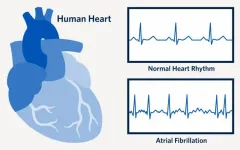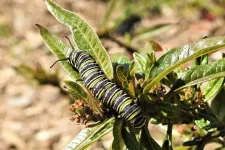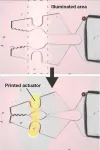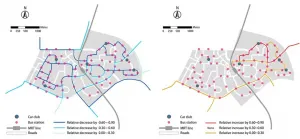The next four years: Forecasting child health policy issues
2021-05-05
(Press-News.org) A hot topic symposia session during thePediatric Academic Societies (PAS) 2021 Virtual Meeting will provide a forum for policy and physician experts to predict major child health legislative and policy changes which will occur over the next four years.
The outcome of the presidential election has significant impact on the child health policy agenda. The goal of the session is to prepare academic pediatricians so they can be ideally positioned to promote or impede specific policies which are not evidenced-based to improve child health.
"The subject matter experts will peer into their crystal balls and help estimate how policies will shape the health of children over the next four years," said Shetal Shah, MD. "More importantly, these presentations will represent a call to action for pediatricians, parents, teachers and all those who care for children about how to advance a child health policy agenda."
The session will address federal legislative and regulatory issues expected to occur over the next four years and their impact on child health insurance rates and access. It will discuss expected federal actions and implications for drug pricing, particularly for medications aimed at treating rare disease. Experts will predict changes in funding level and federal priorities for National Institutes of Health related to pediatric research. The session will also increase awareness of how expected policy changes will impact vulnerable child populations, including immigrant children and children in poverty.
Presentations will focus on five major areas of concern to pediatricians and researchers:
Health insurance coverage for kids; presenter: Stephanie Glier, MPH - American Academy of Pediatrics
Pediatric drug and device development; presenter: Jonathan Davis, MD - Tufts Children's Hospital
The pediatric research funding environment; presenter: James Baumberger, MPP - American Academy of Pediatrics
Healthcare disparities/poverty; presenter: Benard Dreyer, MD - NYU Grossman School of Medicine
Immigrant issues; presenter: Julie Linton, MD - American Academy of Pediatrics
Dr. Shah will chair the session, "The Next Four Years: Forecasting Child Health Policy Issues," on Tuesday, May 4 at 2 p.m. EDT. Reporters interested in an interview with the presenters should contact PAS2021@piercom.com.
The PAS Meeting connects thousands of pediatricians and other health care providers worldwide. For more information about the PAS Meeting, please visit http://www.pas-meeting.org.
INFORMATION:
About the Pediatric Academic Societies Meeting
The Pediatric Academic Societies (PAS) Meeting connects thousands of pediatricians and other health care providers worldwide. This international gathering offers opportunities for a global audience of physician-scientists, clinicians, and educators to share research, explore new ideas, build career opportunities, and collaborate on future projects. The PAS Meeting is produced through a partnership of four pediatric organizations that are leaders in the advancement of pediatric research and child advocacy: American Pediatric Society, Society for Pediatric Research, Academic Pediatric Association and American Academy of Pediatrics. For more information, please visit http://www.pas-meeting.org. Follow us on Twitter @PASMeeting, Instagram PASMeeting and #PAS2021, and like us on Facebook PASMeeting.
[Attachments] See images for this press release:

ELSE PRESS RELEASES FROM THIS DATE:
2021-05-05
The emergence and spread of new forms of resistance remains a concern that urgently demand new antibiotics. Transcription is a vital process in bacterial cell, where genetic information in DNA is transcribed to RNA for the translation of proteins that perform cellular function. Hence, transcription serves as a promising target to develop new antibiotics because inhibition the transcription process should effectively kill the bacteria. Bacterial RNA Polymerase, the core enzyme for transcription, must load the DNA and separate the double-stranded DNA to single stranded DNA to read the genetic information to initiate transcription. This process is also called DNA melting and is facilitated ...
2021-05-05
ORLANDO, May 5, 2021 - New research indicates that the legendary Sargasso Sea, which includes part of the Bermuda Triangle and has long featured in fiction as a place where ships go derelict, may actually be an important nursery habitat for young sea turtles.
In a study led by a University of Central Florida researcher and published today in the journal Proceedings of the Royal Society B, researchers presented evidence of baby green sea turtles arriving at the Sargasso Sea after entering the ocean off the east coast of Florida.
The study was the first time that green sea turtles have been tracked during their early "lost years," which is defined ...
2021-05-05
A UBC Okanagan researcher is urging people to learn and then heed the symptoms of Atrial Fibrillation (AF). Especially women.
Dr. Ryan Wilson, a post-doctoral fellow in the School of Nursing, says AF is the most commonly diagnosed arrhythmia (irregular heartbeat) in the world. Despite that, he says many people do not understand the pre-diagnosis symptoms and tend to ignore them. In fact, 77 per cent of the women in his most recent study had experienced symptoms for more than a year before receiving a diagnosis.
While working in a hospital emergency department (ED), Dr. Wilson noted that many patients came in with AF symptoms that included, but were not limited to, shortness of breath, feeling of butterflies (fluttering) in the chest, dizziness or general fatigue. Many women ...
2021-05-05
Seeing through smog and fog. Mapping out a person's blood vessels while monitoring heart rate at the same time--without touching the person's skin. Seeing through silicon wafers to inspect the quality and composition of electronic boards. These are just some of the capabilities of a new infrared imager developed by a team of researchers led by electrical engineers at the University of California San Diego.
The imager detects a part of the infrared spectrum called shortwave infrared light (wavelengths from 1000 to 1400 nanometers), which is right outside of the visible spectrum (400 to 700 nanometers). Shortwave infrared imaging is not to be confused with thermal imaging, which detects much longer infrared wavelengths ...
2021-05-05
A new Tel Aviv University study has revealed, for the first time, that bats know the speed of sound from birth. In order to prove this, the researchers raised bats from the time of their birth in a helium-enriched environment in which the speed of sound is higher than normal. They found that unlike humans, who map the world in units of distance, bats map the world in units of time. What this means is that the bat perceives an insect as being at a distance of nine milliseconds, and not one and a half meters, as was thought until now.
The Study was published in PNAS.
In order to determine ...
2021-05-05
PULLMAN, Wash. -- A count of the Western Monarch butterfly population last winter saw a staggering drop in numbers, but there are hopeful signs the beautiful pollinators are adapting to a changing climate and ecology.
The population, counted by citizen scientists at Monarch overwintering locations in southern California, dropped from around 300,000 three years ago to just 1,914 in 2020, leading to an increasing fear of extinction. However, last winter large populations of monarchs were found breeding in the San Francisco and Los Angeles areas. Prior to last winter, it was unusual to find winter breeding by monarchs ...
2021-05-05
The idea of deriving health benefits from live microorganisms is well known, but some non-living microorganisms, too, can have beneficial health effects. Yet even with an increasing number of scientific papers published on non-viable microbes for health, the category is not well defined and different terms are used in different contexts.
Now, a group of international experts has clarified this concept in a recently END ...
2021-05-05
A study published in Cretaceous Research expands the paleontological richness of continental fossils of the Lower Cretaceous with the discovery of a new water plant (charophytes), the species Mesochara dobrogeica. The study also identifies a new variety of carophytes from the Clavator genus (in particular, Clavator ampullaceus var. latibracteatus) and reveals a set of paleobiographical data from the Cretaceous much richer than other continental records such as dinosaurs'.
Among the authors of the study are Josep Sanjuan, Alba Vicente, Jordi Pérez-Cano and Carles Martín-Closas, members of the Faculty of Earth Sciences and the Biodiversity Research Institute (IRBio) of the University of Barcelona, in collaboration with the expert Marius Stoica, ...
2021-05-05
Ishikawa, Japan - Inside our cells, and those of the most well-known lifeforms, exist a variety of complex compounds known as "molecular motors." These biological machines are essential for various types of movement in living systems, from the microscopic rearrangement or transport of proteins within a single cell to the macroscopic contraction of muscle tissues. At the crossroads between robotics and nanotechnology, a goal that is highly sought after is finding ways to leverage the action of these tiny molecular motors to perform more sizeable tasks in a controllable manner. However, achieving this goal will certainly be challenging. "So far, even though researchers ...
2021-05-05
Singapore, 5 May 2021 - The rapid advancement of Autonomous Vehicles (AV) technology in recent years has changed transport systems and consumer habits globally. As countries worldwide see a surge in AV usage, the rise of shared Autonomous Mobility on Demand (AMoD) service is likely to be next on the cards. Public Transit (PT), a critical component of urban transportation, will inevitably be impacted by the upcoming influx of AMoD and the question remains unanswered on whether AMoD would co-exist with or threaten the PT system.
Researchers at the Future Urban Mobility (FM) Interdisciplinary Research Group (IRG) at Singapore-MIT Alliance for Research and Technology (SMART), MIT's research enterprise in Singapore, and Massachusetts ...
LAST 30 PRESS RELEASES:
[Press-News.org] The next four years: Forecasting child health policy issues








